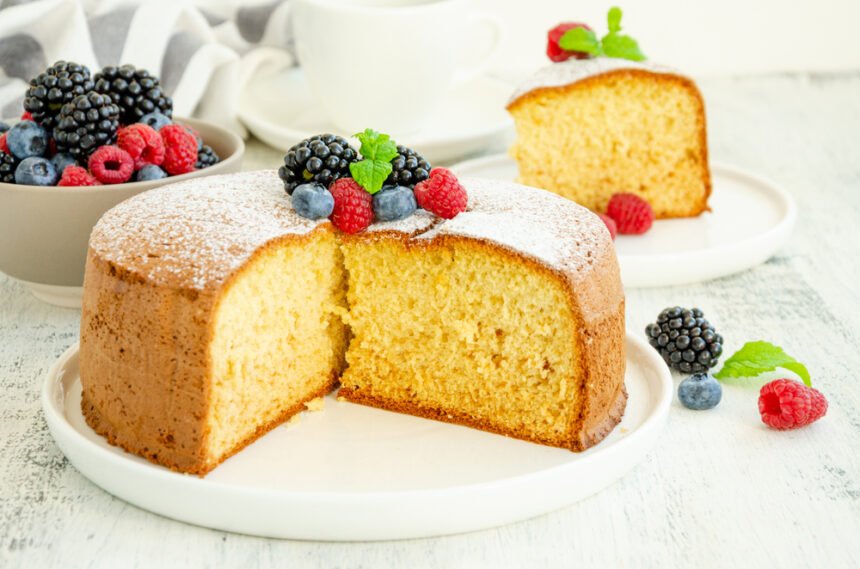You may have thought that you had to give up eating desserts if you want to lose weight, but nothing could be further from the truth! In fact, one study from Israel shows that eating dessert may even be necessary to lose weight.
Ah, cake—the ultimate comfort food and the bane of every dieter’s existence. It’s a delicious treat that we often enjoy on special occasions or when we need to drown our sorrows in a sugary delight.
But what if you could have your cake and eat it too, without any guilt? That’s right, healthy cakes do exist, and they’re here to revolutionize the way you indulge in desserts. There are a lot of ways to have desserts be healthier, such as replacing processed sugars with exotic chocolates.
In this article, we’ll explore how you can create scrumptious yet nutritious cakes by choosing healthier ingredients, reducing refined sugars, incorporating whole grains, utilizing healthy fats, adding fruits and vegetables, experimenting with alternative sweeteners, and enjoying these delectable creations in moderation.
Say goodbye to the days of feeling guilty after eating dessert; instead, learn how to satisfy your sweet tooth while still maintaining a balanced diet.
Let the baking begin! If you want more ideas, the Food Network has a list of 66 great healthy desserts to try.
Choosing Nutritious Ingredients
You’ll love discovering how to choose nutritious ingredients that will make your sweet treats both delicious and wholesome. Start by selecting high-quality, whole foods for your base ingredients, such as whole wheat or almond flour instead of refined white flour. Opt for natural sweeteners like honey or maple syrup over processed sugars.
Don’t forget to incorporate fruits and vegetables into your cakes; they not only add flavor but also essential nutrients, fiber, and moisture. When choosing fats for your healthy cake recipes, look for sources that are rich in heart-healthy monounsaturated and polyunsaturated fats. For instance, swap out butter with avocado or coconut oil. Experimenting with different nut butters can also provide a tasty alternative while offering a dose of healthy fats and proteins.
Additionally, consider using yogurt or applesauce as a substitute for some of the oils in your recipes; this will reduce the overall fat content while maintaining moisture in the cake. One more aspect to keep in mind is incorporating nutrient-dense toppings and mix-ins into your recipes. Think beyond the typical chocolate chips and sprinkles; instead, opt for antioxidant-rich dark chocolate pieces or cacao nibs.
Add texture by mixing in nuts or seeds that pack a nutritional punch, like almonds, walnuts, chia seeds, or flaxseeds. As you explore these healthier ingredient options and combinations, you’ll find it even easier to create guilt-free desserts without losing out on taste!
Next up, let’s discuss how you can further enhance the healthiness of your cakes by reducing refined sugars in your recipes.
Reducing refined sugars
In your quest to reduce refined sugars, consider incorporating natural sweeteners and fruit purees for a more sophisticated and health-conscious treat. Natural sweeteners such as honey, maple syrup, and dates offer a lower glycemic index compared to white sugar, making them a better option for blood sugar control.
Fruit purees like applesauce or mashed bananas can also be used as substitutes for sugar while increasing the nutritional content of your dessert. Experiment with different ratios of natural sweeteners and fruit purees in your cake recipes to find the perfect balance between sweetness and moistness. Keep in mind that liquid sweeteners like honey or maple syrup may require adjustments in the amounts of other liquids in the recipe.
It’s crucial to maintain the right consistency so that your cake doesn’t become too dense or fall apart easily. There are numerous online resources available with guidelines on how to substitute refined sugars with healthier alternatives without compromising taste or texture. By reducing refined sugars in your healthy cake recipes, you’ll not only enjoy guilt-free desserts but also provide better nutrition for yourself and your loved ones.
Remember that moderation is key; even natural sweeteners should be consumed responsibly as part of a balanced diet. As you continue exploring healthier baking options, look into incorporating whole grains into your dessert creations for added fiber and nutrients, which will further elevate your guilt-free indulgences.
Incorporating Whole Grains
Incorporating whole grains into your baking adventures doesn’t just boost nutritional content; it also adds delightful textures and flavors to your sweet treats. Whole grains are less processed than refined flours, so they contain more fiber, vitamins, and minerals. They can even help regulate blood sugar levels and keep you fuller for longer periods of time.
Some popular whole grain options for baking include whole wheat flour, spelt flour, oat flour, and almond flour. Experimenting with different ratios of whole grain flours in your recipes is a simple way to find the perfect balance between taste and nutrition. Start by replacing half of the all-purpose flour in a recipe with a whole-grain alternative like whole wheat or spelt. Gradually increase the amount as desired while keeping an eye on texture and flavor differences. Keep in mind that denser flours, such as almond, may require adjustments in other ingredients like liquids or leavening agents to achieve the right consistency.
Don’t be afraid to get creative! Mix different types of whole grain flours together to create unique combinations that cater to your taste preferences. Remember that some flours work better for certain applications. For example, oat flour is great for making moist cakes, while almond flour lends itself well to dense baked goods like brownies or blondies.
As you continue exploring healthy cake recipes with whole grains, you’ll soon discover new ways to satisfy your sweet tooth without compromising your health goals.
Up next: let’s dive into utilizing healthy fats for even more wholesome dessert options!
Utilizing healthy fats
It’s time to embrace the benefits of using wholesome fats in your baking, as they can enhance both flavor and texture while providing essential nutrients. Healthy fats, such as avocado, coconut oil, and nut butters, are excellent alternatives to traditional butter or shortening when making cakes that not only taste delicious but also promote health.
By incorporating these healthier options into your recipes, you’ll be able to indulge in delectable desserts without an ounce of guilt. One popular choice for a healthy fat is avocado; it works wonders in chocolate cake recipes by adding a creamy texture and rich flavor while being packed with heart-healthy monounsaturated fats. Similarly, coconut oil is another fantastic option, as it contains medium-chain triglycerides (MCTs) that have been shown to support weight management and brain health. Nut butters like almond or cashew offer their own unique flavors and textures, along with a dose of protein and healthy fats that contribute to satiety.
When experimenting with these healthy fat alternatives in your cake recipes, keep in mind that trial-and-error may sometimes be necessary since each ingredient behaves differently than conventional butter or shortening. As you explore new ways to incorporate wholesome fats into your desserts, don’t forget the plethora of fruits and vegetables available for even more nutritious additions!
Adding fruits and vegetables
You’ll be amazed at how fruits and vegetables can elevate the taste, texture, and nutrition of your baked goods, all while keeping things wholesome and enjoyable. Not only do they add natural sweetness, but they also provide essential vitamins, minerals, and fiber that make your guilt-free desserts even more satisfying. In short, there are a number of healthy reasons to eat more of certain fruits and vegetables. Experiment with these nutritious ingredients to create mouthwatering cakes:
- Fruits:
- Applesauce or mashed bananas can replace some or all of the oil in a recipe for a lighter cake with added flavor.
- Pureed berries or citrus zest lend a burst of color and tanginess to your treats.
- Vegetables:
- Grated zucchini or carrots give cakes an irresistibly moist texture while packing in extra nutrients.
- Incorporating pumpkin puree or sweet potato adds natural sweetness without overwhelming the other flavors.
Using fruits and vegetables in your healthy cake recipes not only enhances their nutritional value but also allows you to cut back on less healthy ingredients like sugar, butter, and oil. For instance, applesauce’s natural sweetness lets you reduce the amount of added sugar needed in some recipes. Similarly, substituting avocado for butter provides a creamy consistency without unhealthy fats.
As you continue to explore healthier dessert options, don’t hesitate to experiment with alternative sweeteners such as honey, maple syrup, or stevia. These options can further complement the natural flavors of your fruit-and-vegetable-infused cakes while maintaining their guilt-free status.
Ready to dive into this world of deliciousness? Let’s move on to discovering how these alternative sweeteners can take your desserts to new heights!
Experimenting with Alternative Sweeteners
Can’t wait to sweeten things up without piling on the calories? Let’s explore how alternative sweeteners can transform your baking game!
Traditional sugar may be a staple in most dessert recipes, but it’s far from the only option available. Experimenting with natural sweeteners like honey, maple syrup, and coconut sugar not only allows you to indulge guilt-free but also adds unique flavors and textures to your cakes.
One popular alternative is stevia, a plant-based sweetener that has zero calories and doesn’t spike blood sugar levels. Stevia is much sweeter than regular sugar, so you’ll need less of it in your recipes; about one teaspoon of stevia is equivalent to a cup of sugar.
Another great choice is erythritol, a low-calorie sugar alcohol that tastes similar to table sugar but has a minimal impact on blood glucose levels. When using erythritol or other sugar alcohols like xylitol, keep in mind that they can cause digestive discomfort if consumed in large quantities.
Swapping out traditional sugars for healthier alternatives doesn’t mean you have to sacrifice taste or texture. Remember that each sweetener has its own unique properties and may require some adjustments to your recipe; start by substituting half the amount of regular sugar with an alternative and adjust according to taste.
By experimenting with different options and incorporating healthy cake ideas, such as using whole wheat flour, adding fruits or vegetables, or using Greek yogurt instead of butter, you’ll find the perfect balance between indulgence and healthfulness in your desserts—just remember that even healthy treats should be enjoyed in moderation!
Now let’s dive into smart portion control strategies for truly guilt-free indulgence.
Enjoying in Moderation
Finding the right balance in portion sizes is key to truly savoring your sweet treats without overdoing it. While indulging in healthier cake recipes can alleviate some guilt, it’s still essential to practice moderation when enjoying dessert. By controlling your serving size, you can relish in the taste of your favorite sweets without compromising your healthy eating habits or feeling weighed down after consuming a large piece of cake.
Here are three practical tips for enjoying desserts in moderation:
- Share with others: Instead of eating an entire slice by yourself, share it with a friend or family member. This way, you can still enjoy the flavors and textures of the dessert while consuming less.
- Use smaller plates. Choosing a smaller plate for dessert helps control portion sizes and tricks your brain into thinking you’re eating more than you actually are.
- Savor each bite. Slow down and take time to enjoy each mouthful thoroughly. Appreciating the taste and texture will help satisfy your cravings without needing to eat more than necessary.
By practicing these mindful techniques while enjoying healthier cake recipes, you’ll be able to indulge guilt-free while maintaining control over portion sizes. It’s important not just for weight management but also for overall wellbeing that we learn how to delight our taste buds without sabotaging our health goals.
So go ahead—enjoy those delicious guilt-free cakes responsibly, knowing that moderation is key to savoring life’s sweetest moments!
Conclusion
So go ahead and have your cake and eat it too! With these healthy cake recipes at your fingertips, you can indulge in delicious desserts without the guilt.
Just remember to choose nutritious ingredients, reduce refined sugars, incorporate whole grains, and experiment with alternative sweeteners. Don’t forget that moderation is still key when enjoying these treats.
Savor each bite, knowing that you’re treating yourself to a healthier version of your favorite dessert. Cheers to a healthier indulgence!








